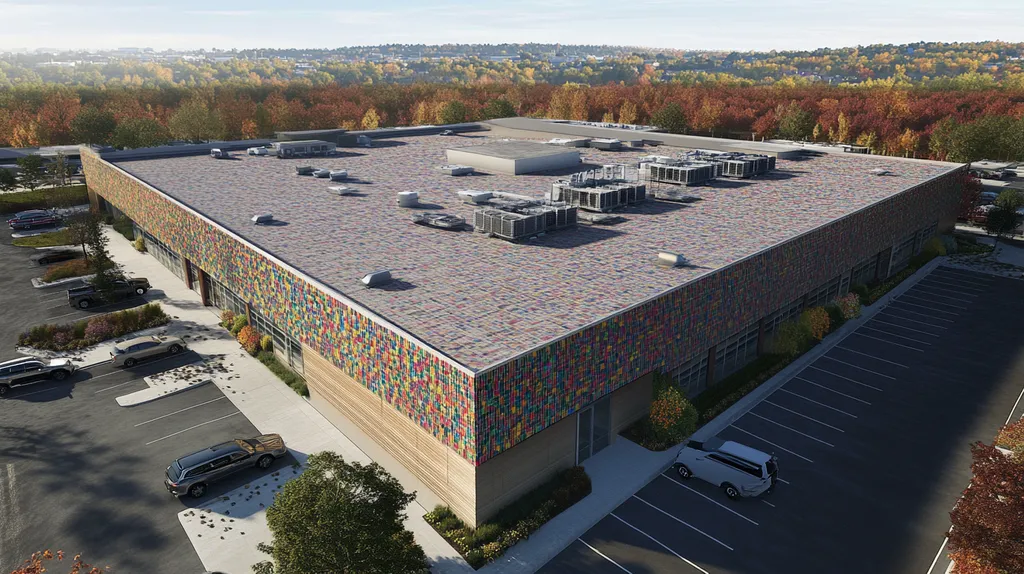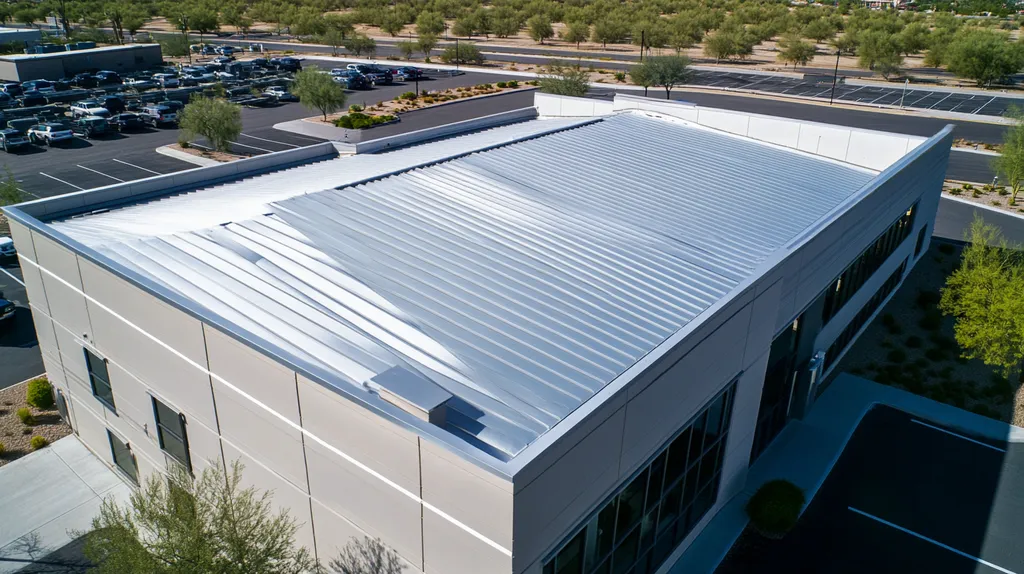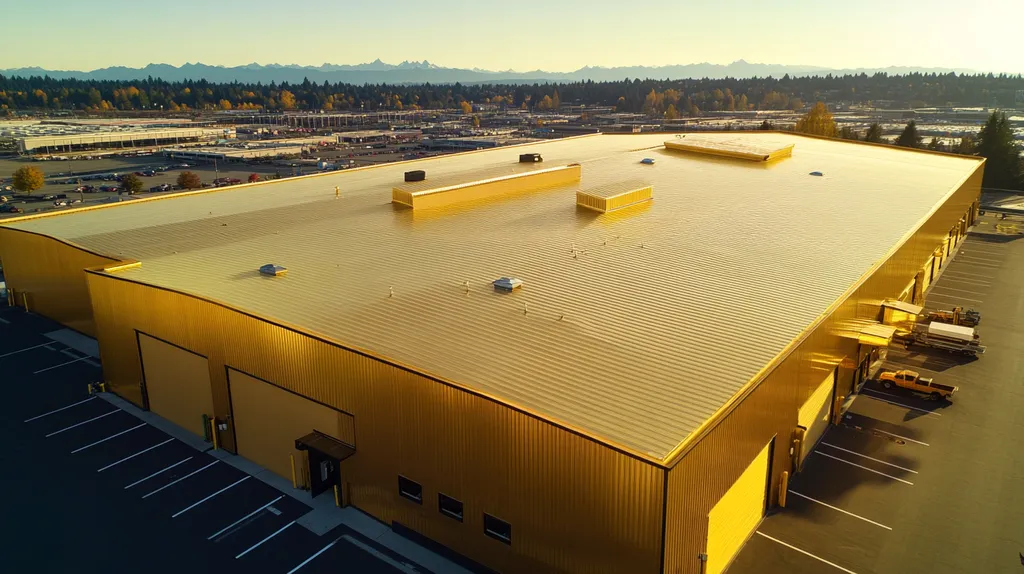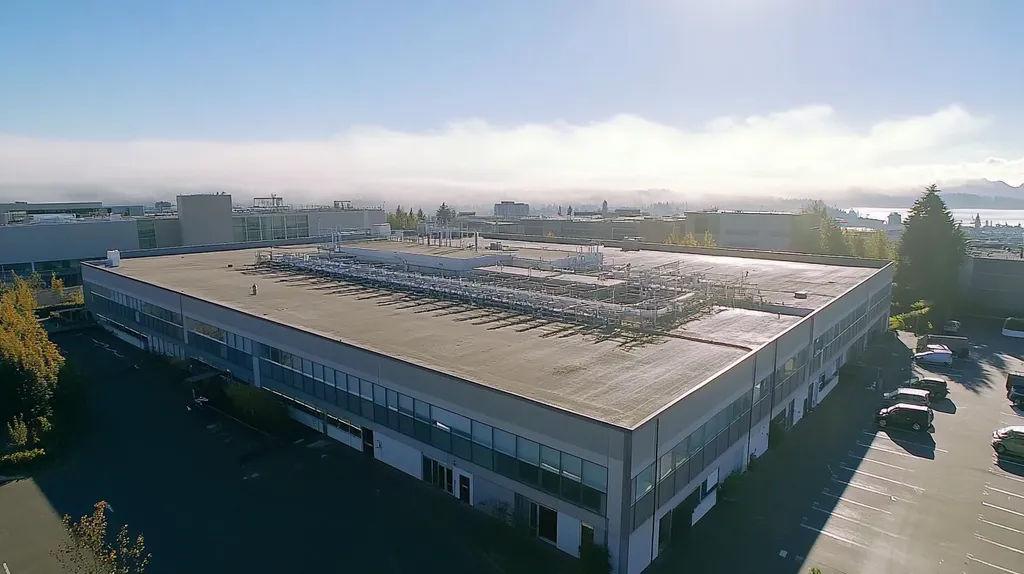In an era where commercial buildings account for 40% of global energy consumption, the stakes for sustainable roofing have never been higher. Every decision about roofing materials and systems can dramatically impact both environmental footprint and bottom-line costs.
From cool roofs that can slash cooling expenses by 30% to green installations that extend roof lifespans by decades, sustainability features are revolutionizing commercial roofing economics.
This comprehensive guide examines how sustainable roofing choices affect initial investments, ongoing operational costs, and long-term returns while navigating the complex landscape of materials, technologies, and implementation strategies.
SECTION 1: FUNDAMENTAL CONCEPTS
In today’s world, understanding sustainability in commercial roofing isn’t just a nice-to-have; it’s a must. Recent studies indicate that an astonishing 30% of a building’s energy consumption can be traced back to poorly performing roofs. By making smart choices about roofing materials and designs, property owners can significantly minimize both their environmental impact and long-term costs. This section will dive into what sustainability in roofing truly means, examine the environmental effects of different roofing materials, and outline essential energy efficiency principles connected to roof design.
Defining Sustainability in Roofing
Sustainability in roofing encompasses practices and materials designed to meet today’s needs without compromising the ability of future generations to meet theirs. This means choosing materials that are recyclable, minimally impact the environment during production, and enhance a building’s energy efficiency. When property owners grasp these concepts, they can make decisions that benefit both their finances and the planet.
For instance, selecting materials like metal or TPO (thermoplastic olefin) not only boosts a roof’s durability but also facilitates recycling once the roof’s life is over. By embracing sustainable roofing practices, properties can achieve certifications such as LEED, which makes them more appealing to eco-conscious tenants and buyers.
Furthermore, sustainability isn’t just about materials; it applies to the entire roofing system’s life cycle. From sourcing and installation to eventual disposal, each stage has a significant ecological impact. Thus, property owners should adopt a comprehensive perspective when weighing roofing options.
Incorporating sustainable practices not only supports a healthier environment but can also lead to financial perks, such as lower energy bills and potential tax breaks. Careful selection of sustainable roofing solutions can yield a solid, long-lasting investment for buildings of all types.
Environmental Impact of Roofing Materials
Choosing the right roofing material can have a profound effect on the environment. Conventional materials like asphalt can lead to pollution during their production and disposal. In contrast, sustainable materials—such as recycled shingles, metal, and green roofs—typically leave a lighter environmental footprint.
Take green roofs, for example; they provide natural insulation while promoting biodiversity, helping to counteract the urban heat island effect. Research shows that implementing a green roof can lower energy costs by as much as 25%, all while effectively managing stormwater.
Moreover, many roofing materials are energy-intensive to produce, contributing to greenhouse gas emissions. Selecting materials with lower embodied energy can significantly lessen a roof’s overall environmental impact. Property owners should actively seek certifications that indicate reduced environmental harm when selecting roofing materials.
It’s also crucial to inspect roofing products for harmful chemicals. Materials free from harmful volatile organic compounds (VOCs) can enhance indoor air quality, providing health benefits for building occupants and the surrounding environment.
Energy Efficiency Basics
Energy efficiency in roofing plays a vital role in minimizing operational costs and reducing environmental impact. A well-insulated roof helps cut down energy use for heating and cooling significantly. Thus, property owners should focus on reflective and insulated materials that maintain stable indoor temperatures.
For example, cool roofing systems catch sunlight rather than absorb it, dramatically lowering cooling costs in the warmer months. According to the Cool Roof Rating Council, a cool roof can save property owners up to 30% on their energy bills during summer.
But materials alone won’t do the trick; the roof’s design and installation are just as critical for energy efficiency. Effective insulation combined with smart ventilation strategies can enhance a building’s overall energy performance. Partnering with skilled roofing professionals can ensure all components work seamlessly together.
Ultimately, investing in energy-efficient roofing solutions not only translates to lower utility bills but also bolsters property value. With rising energy costs and stricter regulations emphasizing climate impact, energy efficiency is evolving into an essential consideration for commercial roofing.
SECTION 2: SYSTEM COMPONENTS
As commercial property owners and facility managers navigate a landscape increasingly shaped by regulations and consumer awareness, prioritizing sustainability in roofing is more crucial than ever. The choices made in roofing materials and systems can create a ripple effect, influencing not only immediate expenses but also long-term savings. For example, while green roofing options may come with a higher initial price tag, they often lead to substantial energy efficiency and improved durability over time. Understanding the various components of roofing systems is key to making savvy, cost-effective decisions in today’s competitive market.
Eco-Friendly Roofing Materials
Utilizing eco-friendly roofing materials is more than just a trend; it’s a vital step toward achieving sustainability. Traditional roofing materials can be laden with harmful chemicals and consume significant energy during production. In contrast, innovative options like recycled metal, rubber, and sustainably sourced wood provide a greener alternative while reducing environmental impact.
Moreover, these sustainable materials often come with lower maintenance costs over their life cycles. For instance, cool roofs made of reflective materials can minimize heat absorption and lower energy bills, resulting in cost savings and extending the lifespan of the roof.
Choosing eco-friendly materials can raise a building’s market value as well. Properties featuring sustainable components often attract environmentally conscious tenants, granting a significant edge in today’s leasing landscape. In the long run, these thoughtful choices support both the environment and financial health.
Cool Roofing Systems and Coatings
Cool roofing systems are engineered to reflect more sunlight and absorb less heat than conventional roofs, resulting in significant reductions in energy consumption. Buildings equipped with cool roofs can experience a drop in cooling costs of up to 15%, particularly in warmer regions. This energy efficiency positively impacts operational expenses.
Additionally, applying reflective coatings to existing roofs offers a budget-friendly enhancement without requiring a full replacement. These coatings not only increase energy efficiency but also shield roofs from damaging elements, such as UV rays and moisture, thus prolonging their lifespan.
With sustainability regulations tightening, cool roofing systems can also help commercial properties achieve sustainability certifications, boosting their marketability. Property owners should weigh the initial investment against the potential long-term savings and benefits.
Green Roofing and Vegetation Integration
Green roofs, which integrate vegetation, are rapidly gaining popularity in the commercial roofing sector. They offer numerous benefits, including improved insulation, reduced stormwater runoff, and better air quality. These roofs help maintain stable internal temperatures, translating to notable energy savings.
Beyond energy efficiency, green roofs promote biodiversity and ecological benefits. They can rejuvenate otherwise underutilized rooftop spaces into lush gardens, enhancing tenant satisfaction and retention. Research indicates that green surfaces can reduce heating requirements by 10%–30%, and in summer, temperature differences between conventional and green roofs can reach up to 12°C.
Although the initial costs for green roofs may seem daunting, various incentives, like tax credits and stormwater management credits, can help offset expenses. As cities increasingly recognize the merits of green roofing, the long-term return on investment makes them an attractive option for property owners.
SECTION 3: IMPLEMENTATION METHODS
The call for sustainability in commercial roofing has reached a critical point. With energy costs soaring and regulations tightening, property owners cannot afford to ignore eco-friendly options any longer. In fact, buildings are responsible for nearly 40% of carbon emissions. This section will explore three impactful strategies to not only cut costs but also champion sustainability: installing metal and recyclable roofs, integrating solar roofing systems, and implementing reflective and insulative membranes.
Installing Metal and Recyclable Roofs
Metal roofs are becoming a top choice for commercial properties that are serious about sustainability. They are durable, often outlasting traditional roofs, which means lower replacement rates and a decrease in waste over time. Many metal roofing options also incorporate recycled materials, further shrinking the environmental footprint.
On top of their durability, metal roofs shine in energy efficiency. Research indicates that their reflective surfaces can significantly cut cooling costs, leading to lower energy bills as they decrease reliance on air conditioning.
Thanks to advancements in installation techniques such as snap-lock and standing seam technologies, metal roofs can be set up quickly and easily, reducing labor costs. Plus, their lightweight nature can lessen the need for additional structural support.
Investing in a metal roof often translates to substantial long-term savings—outpacing the initial costs. As sustainability becomes a growing priority, manufacturers are innovating their processes, making metal roofing options more affordable and accessible than ever.
Integrating Solar Roofing Systems
Solar roofing systems offer a cutting-edge method to generate energy while protecting against rising utility bills. Installing photovoltaic panels transforms sunlight into electricity, enabling businesses to lower their reliance on grid power and their energy expenses over time.
Many states also provide enticing incentives for solar installations, such as tax credits and rebates, making the initial investment even more palatable. A well-installed solar roofing system can even enhance the lifespan of the building’s roof.
There’s also a unique integration potential—some solar solutions merge traditional roofing materials with solar technology, boosting both aesthetics and functionality. This combination helps properties stand out in a competitive market, demonstrating a commitment to sustainability.
With the rapid advancements in solar technology and a plethora of financing options available, integrating solar roofing systems is a savvy move for commercial building owners looking to future-proof their properties.
Implementing Reflective and Insulative Membranes
Reflective and insulative membranes are critical components of a sustainable roofing strategy. These innovative membranes not only safeguard roofs against potential leaks but also significantly enhance energy efficiency. By incorporating reflective membranes, facilities can minimize heat absorption, lowering cooling costs during the summer months.
For facilities managers, the advantages are clear. Reflective membranes aid in maintaining comfortable indoor temperatures, reducing the strain on HVAC systems. This not only translates to lower energy bills but also extends the lifespan of heating and cooling equipment.
In addition to reflective properties, insulative membranes efficiently reduce heat transfer, keeping buildings warm during winter and cool in summer. Consequently, overall energy consumption drops, aligning daily operations with sustainability objectives.
Many manufacturers are now producing membranes using environmentally friendly materials, boosting their sustainability profiles. By adopting these proactive strategies, property owners invest in long-lasting benefits—both economically and ecologically.
SECTION 4: MAINTENANCE REQUIREMENTS
Ignoring your commercial roof’s maintenance can open the floodgates to hefty repair bills and potential catastrophe. Did you know that over 30% of roofing failures stem from inadequate upkeep? That’s a significant number, indicating that smart property owners must actively manage their roofs to ensure sustainability features shine, costs remain manageable, and the life of their investment is maximized.
Routine Inspection and Repair
Regular inspections are the lifeblood of a commercial roof’s health. It’s like getting a physical for your building—experts suggest scheduling inspections at least twice a year, particularly after extreme weather events. This proactive strategy allows property owners to catch sneaky leaks and signs of wear before they turn into bigger headaches.
Timely repairs can significantly trim down overall roofing costs. Tackling minor issues now, like sealing small cracks, can prevent moisture from wreaking havoc and causing mold or structural damage down the line. Think of it as a simple stitch that can avoid the need for major surgery.
Documenting inspection results isn’t just busywork; it’s a smart way to track the roof’s performance over time. Facility managers can use this valuable data for budgeting and can even use it to back up warranties or insurance claims. Keeping records means knowing exactly when and what needs attention.
Skip the inspections, and you risk being blindsided by emergency repairs that not only hit the wallet hard but also disrupt daily business. A solid maintenance plan translates to smoother operations and predictable roofing performance, which benefits both the business’s bottom line and peace of mind.
Weather Resistance and Durability
Selecting robust materials can drastically influence your roof’s maintenance needs and costs over time. Roofs equipped with weather-resistant features—think reflective coatings and high-quality membranes—often need less attention. For example, a roofing system with robust UV resistance can stand up to the sun’s harsh rays, extending its service life.
Moreover, investing in durable materials helps roofs handle extreme weather with ease. Roofs built for heavy rain or snow will require less frequent patching up, ultimately saving money compared to standard roofing solutions that buckle under pressure.
Local climate plays a pivotal role in material selection too. In areas prone to wild weather, choosing resilient roofing options brings long-term savings and sustainability perks. Picking the right components is not just about roofing; it’s about ensuring both environmental and financial viability.
With weather-resistant roofing, buildings tend to face fewer challenges over their lifespan. This not only backs up sustainability efforts but also enhances the overall value of the property.
Extended Lifespan Maintenance Strategies
Employing smart maintenance strategies is essential for maximizing a roof’s performance. Proactive cleaning can prevent debris from piling up and retaining moisture, which can accelerate deterioration. Keeping gutters and drains clear is another crucial step to prolonging your roof’s lifespan.
Routine checks on seals and flashings also deserve attention. These unsung heroes keep leaks at bay, and ignoring them can lead to significant water damage that costs a pretty penny to fix. Regularly tending to these areas helps maintain roof health for years to come.
Training facility staff on minor maintenance tasks can foster a culture of care for the roofing system. With informed teams, simple issues can be handled without the need for external contractors, addressing small problems before they snowball.
A well-crafted maintenance strategy doesn’t just sustain the roof; it also enhances its sustainability profile. By preserving a roof’s functionality, property owners align their operations with broader environmental goals, boosting overall property value in the process.
SECTION 5: PERFORMANCE METRICS
As the urgency for sustainable practices in commercial buildings grows, understanding performance metrics for roofs has never been more vital. A well-designed commercial roof doesn’t just sit above your building; it actively reduces energy consumption, cuts operational costs, and boosts indoor air quality. For example, reflective roofing materials can trim cooling costs by up to 20%. These metrics are essential tools that can shape both financial stability and environmental stewardship.
Energy Consumption and Cost Savings
Energy consumption serves as a crucial metric when assessing your commercial roof’s sustainability. Innovative systems like green roofs or cool roofs can yield significant reductions in energy costs. The U.S. Environmental Protection Agency states that a mere 10% drop in energy use could mean thousands of dollars in annual savings for larger facilities.
Keeping tabs on energy consumption alongside roofing performance equips facility managers to make smarter choices. While investing in energy-efficient materials may seem costly initially, the promise of long-term savings is worth it. Roofs with high solar reflectance are particularly effective in reducing cooling costs, especially in warmer climates.
Moreover, energy-efficient roofs open doors to renewable energy opportunities. By installing solar panels atop commercial roofs, property owners can offset energy expenses while advancing environmental goals. The link between roofing sustainability and energy savings paints a clear picture for proactive facility management.
Ultimately, effectively integrating these metrics underpins cost-saving strategies while promoting a responsibility to the environment. Adopting cutting-edge roofing technologies fosters a more financially sustainable and environmentally-friendly future for buildings.
Carbon Footprint Reduction Metrics
Reducing a building’s carbon footprint is an essential goal for sustainable roofing. Different roofing materials emit varying levels of greenhouse gases during production and installation, with recycled materials typically leaving a lighter ecological footprint than their traditional counterparts.
Facility managers can assess the environmental impact of their roofing decisions using lifecycle assessments. These evaluations track emissions throughout a roof’s life span, offering concrete data for carbon reduction strategies. Fortunately, many manufacturers are now producing materials with lower embodied carbon, a critical shift for organizations dedicated to minimizing their carbon footprints.
Additionally, energy-efficient roofing systems result in reduced operational emissions. Transitioning to sustainable roofing not only adheres to building codes but also aligns with increasing environmental standards. Initiatives like LEED certification encourage minimizing carbon footprints, markedly increasing a property’s appeal.
By effectively monitoring and reporting, commercial property owners can articulate their sustainability initiatives clearly. This transparency fosters stronger stakeholder relationships and attracts eco-conscious tenants, ultimately driving up overall property value.
Indoor Comfort and Air Quality
Indoor comfort and air quality are critical yet often overlooked indicators of roofing performance. Roof design plays a pivotal role in regulating temperature and ventilation, directly impacting occupant well-being. Well-insulated roofs help minimize temperature swings, ensuring comfort while concurrently reducing energy usage.
Monitoring indoor air quality metrics sheds light on how effectively a building’s ventilation systems are operating. Sustainable roofing choices can enhance air quality by utilizing low-VOC materials and adequate insulation. Improved air quality has been linked to greater productivity and higher employee satisfaction, contributing to a healthier work environment.
In addition, green roofs provide natural insulation, boosting indoor comfort during extreme weather. They help stabilize temperatures, promoting consistency year-round while managing stormwater runoff, which adds more environmental benefits.
By prioritizing metrics related to indoor comfort, property owners can amplify the value of investing in sustainable roofing. Aligning roofing decisions with tenant well-being creates spaces that foster productivity and health, ultimately leading to a thriving business environment.
SECTION 5: PERFORMANCE METRICS
In a time when sustainability is no longer optional, understanding performance metrics for commercial roofs has become essential. A well-constructed roof can meaningfully cut energy use, reduce operational costs, and improve the indoor environment. For instance, installing reflective materials can lower cooling expenses by as much as 20%. By focusing on these metrics, property owners can align financial gains with environmental responsibility.
Energy Consumption and Cost Savings
Energy consumption stands at the forefront when analyzing a commercial roof’s sustainability. Innovative systems like green roofs or cool roofs can drive down energy costs significantly. As reported by the U.S. Environmental Protection Agency, just a 10% reduction in energy use can yield hundreds to thousands of dollars in savings for larger facilities each year.
Keeping an eye on energy consumption alongside roof performance empowers facility managers to make informed choices. While investing in energy-efficient materials often requires an upfront spend, the long-term savings can be considerable. Roofs designed with high solar reflectance are particularly effective in reducing cooling costs, especially in hotter regions.
Moreover, energy-efficient roofs can pave the way for renewable energy installations. By adding solar panels to commercial rooftops, property owners not only diminish energy costs but also work toward sustainability goals. This connection between roofing efficiency and energy savings creates a smart strategy for effective facility management.
Ultimately, effectively integrating these metrics bolsters cost-reducing strategies while simultaneously enhancing environmental responsibility. Adopting cutting-edge roofing technologies can guide buildings toward financial sustainability and a lighter ecological footprint.
Carbon Footprint Reduction Metrics
Minimizing a building’s carbon footprint is a cornerstone of sustainable roofing practices. Each type of roofing material releases different levels of greenhouse gases during its production and installation, with recycled materials typically offering a reduced environmental impact compared to standard options.
Facility managers can gauge the environmental effects of their roofing decisions through lifecycle assessments. These assessments track emissions throughout a roof’s lifespan, providing valuable benchmarks for carbon reduction initiatives. Encouragingly, many manufacturers are now developing materials with lower embodied carbon, an important step for organizations looking to shrink their carbon footprints.
Furthermore, energy-efficient roofing systems directly contribute to lower operational emissions. Transitioning to sustainable roofing doesn’t just meet existing building regulations; it also aligns with rising environmental standards. Certification programs like LEED underscore the importance of minimizing carbon footprints, enhancing the market appeal of properties.
With effective tracking and clear reporting, commercial property owners can showcase their sustainability initiatives. This transparency fosters stronger relationships with stakeholders and attracts eco-conscious tenants, ultimately boosting property value.
Indoor Comfort and Air Quality
Indoor comfort and air quality are crucial yet often underappreciated indicators of roofing performance. The design of a roof can significantly influence temperature stability and ventilation in a building, which are vital for occupant satisfaction. Competently insulated roofs help minimize temperature fluctuations, ensuring comfort while cutting back on energy use.
Tracking indoor air quality metrics can provide insights into how well a building’s ventilation systems are functioning. Choosing sustainable roofing materials can promote better air quality through low-VOC options and enhanced insulation. Studies show that improved air quality correlates with greater employee productivity and satisfaction, creating a healthier workplace.
In addition, green roofs offer excellent natural insulation, boosting indoor comfort levels. They help stabilize temperatures, offering pleasant environments year-round while also managing stormwater runoff, which adds to their environmental benefits.
By prioritizing metrics related to indoor comfort, property owners can underline the value of investing in sustainable roofing. Aligning roofing decisions with the well-being of tenants fosters productivity and health, ultimately leading to a vibrant business climate.
The Bottom Line
With commercial buildings accounting for 40% of global energy consumption, sustainable roofing isn’t just an environmental choice—it’s a critical business decision that directly impacts the bottom line.
The data speaks volumes: cool roofs can slash cooling costs by 30%, while green roofs extend lifespans by decades and boost property values by up to 15%.
From innovative materials and smart implementation strategies to rigorous maintenance protocols, sustainable roofing solutions offer a clear path to reduced operational costs and enhanced building performance.
As regulations tighten and energy costs continue to rise, property owners who fail to embrace sustainable roofing risk falling behind in an increasingly competitive market where environmental responsibility drives both tenant decisions and property valuations.
FREQUENTLY ASKED QUESTIONS
Q. What is sustainability in a commercial roof?
A. Sustainability in roofing means using materials and practices that minimize environmental impact. It involves selecting recyclable materials and energy-efficient designs to reduce energy consumption while ensuring durability.
Q. How do eco-friendly materials affect industrial roof costs?
A. While eco-friendly materials may have a higher initial cost, they often lead to lower maintenance and energy costs. Investing in sustainable materials can enhance property value over time, making them cost-effective in the long run.
Q. What are the benefits of reflective roofing systems for commercial roofs?
A. Reflective roofing systems help to reduce heat absorption, leading to lower cooling costs during hot months. They can significantly enhance energy efficiency, decreasing reliance on air conditioning and ultimately saving money.
Q. How often should a commercial roof be inspected?
A. Inspections should occur at least twice a year and after severe weather events. Regular checks help catch potential issues early, preventing costly repairs and ensuring the roof operates efficiently to support sustainability efforts.
Q. How can performance metrics improve commercial roof sustainability?
A. Monitoring performance metrics, like energy consumption and indoor air quality, helps identify areas for improvement. These insights allow property owners to make informed decisions that enhance sustainability while saving on operational costs.
Q. What role does green roofing play in sustainability?
A. Green roofing integrates vegetation, providing insulation, improved air quality, and biodiversity. They help manage stormwater runoff and lower overall energy costs while enhancing the aesthetic appeal and marketability of the property.
Q. How can facility managers promote roof longevity?
A. Implementing a proactive maintenance strategy is key. Regular cleaning, inspections, and repairs of seals can prevent deterioration. Training staff in minor maintenance tasks fosters a culture of care that enhances roof lifespan and performance.










